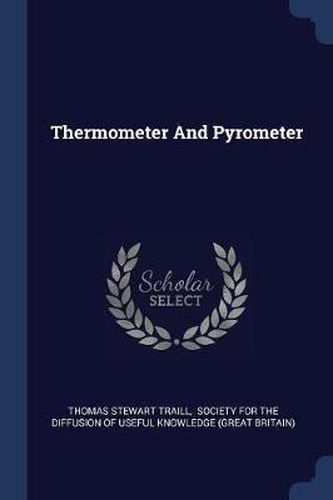Readings Newsletter
Become a Readings Member to make your shopping experience even easier.
Sign in or sign up for free!
You’re not far away from qualifying for FREE standard shipping within Australia
You’ve qualified for FREE standard shipping within Australia
The cart is loading…






This historic book may have numerous typos and missing text. Purchasers can download a free scanned copy of the original book (without typos) from the publisher. Not indexed. Not illustrated. 1828 Excerpt: …of fine silver, applied to a gage on the same principle as that above described. By this, the expansions of the silver for 50 and 212 Fahrenheit were first noted; and then the silver and clay pyrometric pieces were compared at the same temperature. By such means Wedgwood estimated the value of each degree of his scale at 130 of Fahrenheit; and he reckoned that the 0 of his scale corresponded with the 1077.5 of the common scale. On this principle comparative tables of the two thermometers have been constructed; but their accuracy depends on two circumstances which have not been determined to the satisfaction of the philosophic world. Clay being a heterogeneous mixture, it by no means follows that its contractions are equable at different temperatures; and even were this ascertained, there is great doubt how far the means employed by Wedgwood did accurately estimate the degree of Fahrenheit at which his scale commences. There is still another serious objection to the general use of such an instrument. It occurred to the ingenious inventor, that different portions of clay would possess different degrees of contractibility; and he endeavoured to secure uniformity, to a certain extent, by laying in a large stock of Cornish clay, which he hoped would supply innumerable pyrometric pieces of the same quality. It was found, however, that spontaneous changes take place in such clay, which render its indications liable to variation at distant intervals; or pieces, now formed of the same clay, will not give the same indication with pieces baked several years ago. Attempts were made to remedy this inconvenience by forming a clay of uniform quality of fixed proportions of silex and alumine. Fine Cornish clay yielded, on analysis, two parts of silex and three of alumine; …
$9.00 standard shipping within Australia
FREE standard shipping within Australia for orders over $100.00
Express & International shipping calculated at checkout
This historic book may have numerous typos and missing text. Purchasers can download a free scanned copy of the original book (without typos) from the publisher. Not indexed. Not illustrated. 1828 Excerpt: …of fine silver, applied to a gage on the same principle as that above described. By this, the expansions of the silver for 50 and 212 Fahrenheit were first noted; and then the silver and clay pyrometric pieces were compared at the same temperature. By such means Wedgwood estimated the value of each degree of his scale at 130 of Fahrenheit; and he reckoned that the 0 of his scale corresponded with the 1077.5 of the common scale. On this principle comparative tables of the two thermometers have been constructed; but their accuracy depends on two circumstances which have not been determined to the satisfaction of the philosophic world. Clay being a heterogeneous mixture, it by no means follows that its contractions are equable at different temperatures; and even were this ascertained, there is great doubt how far the means employed by Wedgwood did accurately estimate the degree of Fahrenheit at which his scale commences. There is still another serious objection to the general use of such an instrument. It occurred to the ingenious inventor, that different portions of clay would possess different degrees of contractibility; and he endeavoured to secure uniformity, to a certain extent, by laying in a large stock of Cornish clay, which he hoped would supply innumerable pyrometric pieces of the same quality. It was found, however, that spontaneous changes take place in such clay, which render its indications liable to variation at distant intervals; or pieces, now formed of the same clay, will not give the same indication with pieces baked several years ago. Attempts were made to remedy this inconvenience by forming a clay of uniform quality of fixed proportions of silex and alumine. Fine Cornish clay yielded, on analysis, two parts of silex and three of alumine; …